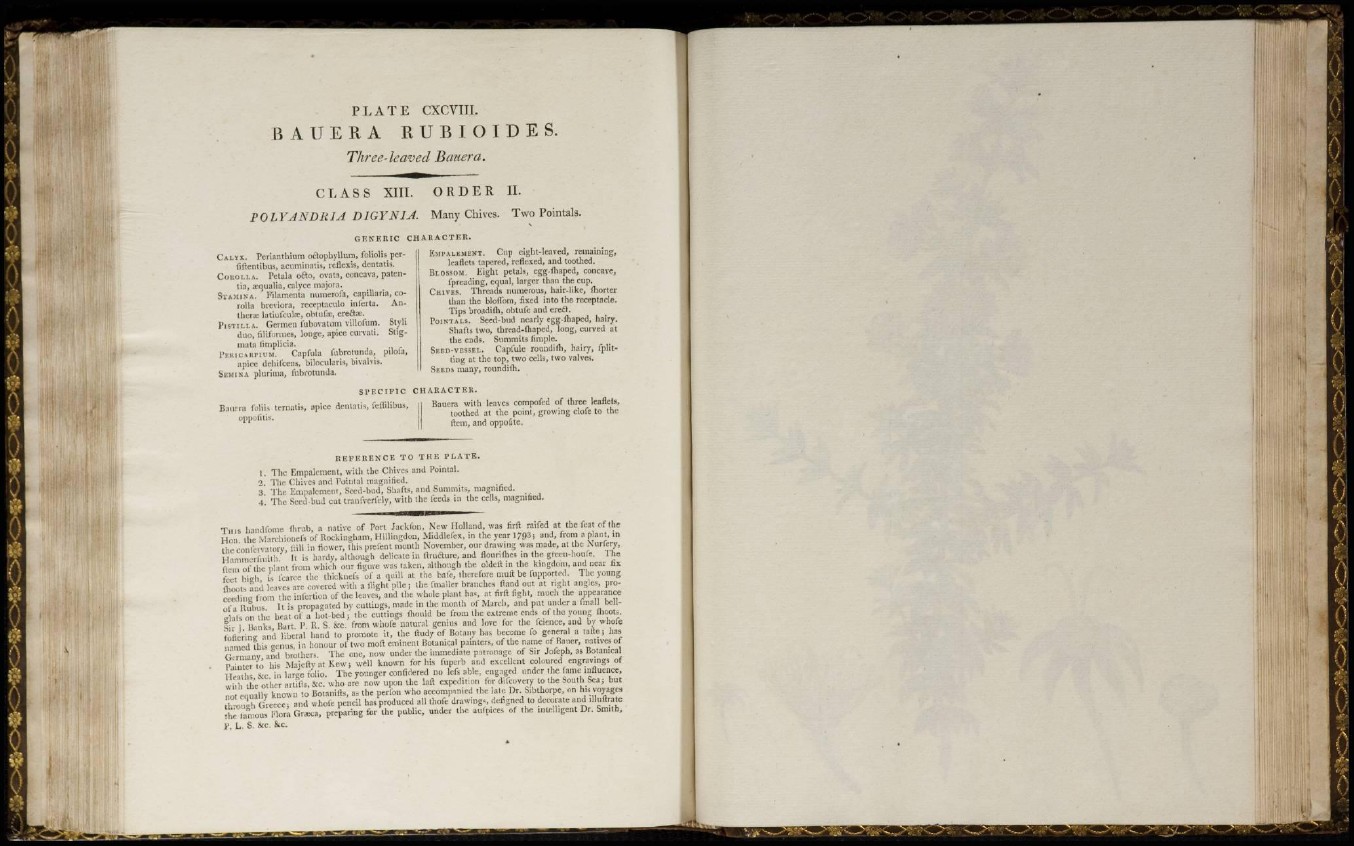
P L A T E CXCVIIL
B . A Ü E R A R U B I O I D E S.
Three-leaved Bauer a.
CLASS XIII. ORDER II.
POL YANDRI A DIGYNIA. Many Chives. Two Pointals.
GENERIC CHARACTER.
C A L Y X . Pcnanthium o&ophylhim, foliolisperfiftentibus,
acuminatis, reflexis, dentatis.
CoitoLLA. Pétala oflo, ovata, concava, patentia,
asqualia, calyce majora.
S T A M I N A . Filamenta numerofa, capillaria, corolla
breviora, receptáculo iuferta. An-
Ihera; latiufeula?, oblnfas, erectas.
P I S T I L L A . Germen fubovatum villofum.
duo, filiformes, longe, ápice curvad,
mata limplícia.
P E R I C A R P I U M . Capfula fubrotunda,
ápice deliifcens, bilocularis, bivaivis.
S E M I N A plurima, fubrotunda.
Styli
Stigpilofa.
EMPALF.MENT. Cup eight-leaved, remaining,
leaflets tapered, reflexed, and toothed.
BLOSSOM. Eight petals, egg-fhaped, concave,
fpreading, equal, larger than the cup.
C H I V E S . Threads numerous, hair-like, (hotter
than the bloflbm, fixed into the receptacle.
Tips broadifh, obtufe and erect.
P O I N T A L S . Seed-bud nearly egg-fhaped, hairy.
Shafts two, thread-ihaped, long, curved at
the ends. Summits fimple.
SEED-VESSEL. Capfule roundihS, hairy, fplitting
at the top, two cells, two valves.
SEEDS many, roimdifli.
S P E C I F I C CHARACTER.
H-iiitrs fold, ternatis, apice dentatis, feflilibus, II Bauera with leaves compofed of three leaflets,
jMaera 10UU t e r n a u s , »piv toothed at the point, growing clofe to the
' |j Item, and oppofite.
REFERENCE TO THE PLATE.
1. The Empalcment, with the Chives and Pointal.
t The Chives and Pointal magnified.
3' The Empalcment, Seed-bud, Shafts, and Summits, magnified.
4 . The Seed-bud cut tranfverfely, with the feeds in the cells, magnified.
T H I S handfome flirub, a native of Port Jacklbn, New Holland, was firfl raifed at the feat of the
Hon. the Marchinncfs of Bockingham, Hillingdon, Middlelex, in the year 1 / Q 3 ; and, from a plant, in
the couletvatory, ltill in flower, this pre lent month November, our drawing was made, at the Nurfery,
Hammerfmith. It is hardy, although delicate in ihucture, and flourilh.es in the gfeen-honfe. Tns
fteni of the plant from which our figure was taken, although the oldefi in the kingdom, and near fix
feet high, is fcarce the thickuefs of 3 quill at the bale, therefore mull be fupported. The young
(hoots and leaves are covered with a flight p i l e ; the fmaller branches Hand out at right angles, proceeding
from the infcrlion of the leaves, and the whole plant h a s at firfl light, much the appearance
o f a Bubus. It is propagated by cuttings, made in the month of March, and put under a final! bellglals
on the heat o f a hut-bed; the cuttings mould be from the extreme ends of the young (hoots.
Sir J . Batiks, Bart. 1'. R. S. &c. from whole natund genius and love for the fcienee, and by whofe
tottering and liberal hand to promote it, the ftudy of Botany lias become fo general a tatte; has
named this genus, in honour of two molt eminent Botanical painters, of the name of Bauer, natives of
G. nnany, and brothers. The one, now under the immediate patronage of Sir Jofcph, as Botanical
fainter to his Majeily at Kcw; well known for his fupcrb and excellent coloured engravings of
Heaths, BSC in large tolio. The younger confirlered no lefs able, engaged under the fame influence,
with the other arlifts, fcc who are now upon the lafl expedition for difcovery to the South Sea; but
not equally known to Botanifts, a.-, the perlbn who accompanied the late Dr. Sibthorpe, on his voyages
through Greece; and whole pencil has produced all thofe drawing-, defigned to decorate and illuflrate
the famous Flora Grata, preparing tor the public, under the aufpices of the Intelligent Dr. Smith,
P. L. S. &c. &c.
I